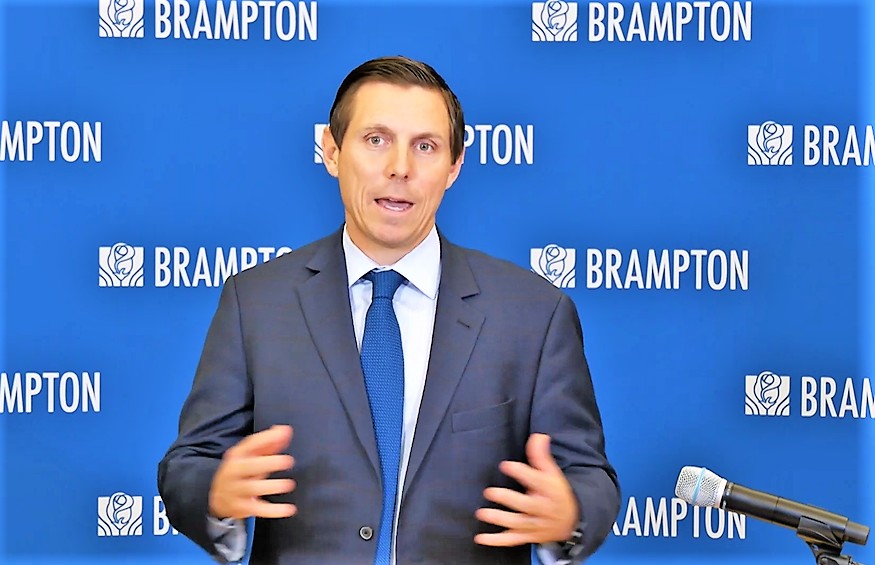
‘Brampton businesses are losing confidence in the City's ability to plan’: Industry heads blast Patrick Brown’s incompetent budget
Ahead of the October 24 municipal election, The Pointer is republishing articles highlighting Patrick Brown’s destructive leadership since becoming Brampton’s mayor. This article was originally published December 3, 2021.
Confidence is at the heart of our economy but for Brampton business leaders, it is running low.
The Brampton Board of Trade, which represents the city’s business community, made a blistering presentation to Brampton City Council’s budget committee on Wednesday night. The organization questioned the accuracy of the City’s 2022 budget, calling for stable, long-term planning and not the short-term tax freezes that have been pushed by Mayor Patrick Brown.
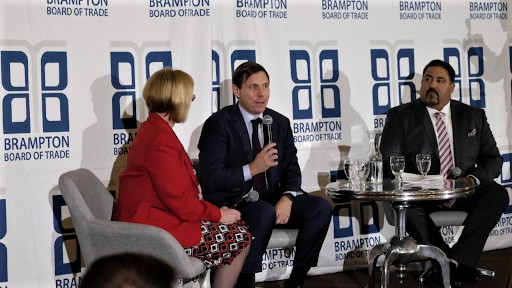
The Brampton Board of Trade has called out Patrick Brown during budget deliberations this week for his poor financial leadership.
(The Pointer file photo)
“Brampton businesses are losing confidence in the City's ability to plan because of the shifting numbers that seem to shift very quickly,” Glenn Williams, a seasoned accountant speaking on behalf of the Brampton Board of Trade, told councillors. He highlighted contradicting information in different reports, last-minute publication of documents and a capital funding shell game as some of the alarming concerns.
“The Board of Trade expects better,” Williams said.
He pointed out that local businesses want stability and long-term transparency above all else.
“Less than 72 hours ago, the third quarter capital project report was issued,” he said. “Within that report was $69 million of projected return of financing for various projects. With a short timeframe, it is very difficult to review some of these reports.”
The report Williams referenced suggests that tens of millions of dollars have been poorly budgeted by staff, who seem incapable of keeping even basic spending plans on track.
Projects that were either mispriced or are massively behind schedule are seeing their council-approved funding being inexplicably put back into the City’s coffers. The woeful management means staff working under the inexperienced leadership of CAO David Barrick, hand-picked by Brown, are failing to deliver the will of elected councillors, who approve projects, on behalf of their constituents’ needs, that may never be built.
The proposed budget presented by Barrick and his senior team, mostly recent hires brought in by the controversial CAO who has no experience ever running even a small municipal department, much less the ninth largest city in Canada, with a billion dollar budget.
“Minor Capital projects are for relatively small expenditures that do not fit into any unique capital project,” the budget document authored by Barrick and his team claims, using language that would make even amateur accountants cringe. “They may be planned or unexpected expenditures and as a result are grouped into one project to provide flexibility in funding each department’s unique operational needs. Costs for the individual components of this capital project may vary from these estimates and therefore there may be some reallocation of funding between these components.”
These are highly questionable claims, suggesting taxpayers will be paying for undefined costs that might never even be actually incurred.
The budget is littered with claims of unforeseen costs, unexpected potential expenditures and vague descriptions for why taxpayers are being charged for items with no understanding of what they are.
For example, under public works and engineering a project number is listed as 222999-001, but the description of the work taxpayers will pay for out of their pockets is, “Miscellaneous / City Wide / City Wide”, meaning there is no idea of what the $120,000 is actually for.
Another project in the department is listed as 221899-001 and has $175,000 allocated for “Minor Capital - Services Systems / City Wide / Various Locations”, again offering no detail of what the money being charged to taxpayers is actually for.
Under the parks department project number 224150-001 is for “Various Studies / City Wide / Various” and will cost taxpayers $350,000, despite no explanation whatsoever of the actual work to be done.
Another engineering expenditure for project 223620-001 is described as “Pre-Engineering / City Wide / Various Locations”, offering no description or detail of what this $750,000 cost is for.
Taxpayers will pay $21 million for road resurfacing projects under three line items, each with a project number, but there is not one word of detail that explains what each specific project is or which roads will be repaired.
The document leaves taxpayers exposed to the possibility of rampant abuse and mismanagement of their money.
“This just creates uncertainty that makes us question how firm those numbers are, how real are those projects?” Williams said in his damning forensic analysis of the City’s financial plan. “We really shouldn't see $69 million of projects suddenly no longer be needed,” he said of the recent capital report which underscored just how inaccurate the budgeting under Barrick and Brown has been.
Barrick was fired from his job at the Niagara Peninsula Conservation Authority, which Ontario’s Auditor General said was given to him inappropriately. Mired in scandal after Barrick, who did double duty as a Port Colborne councillor, plunged the small agency into controversy, regional councillors refused to provide further funding to the NPCA until Barrick accounted for more than approximately $5 million in the 2018 and 2019 budgets that had no explanation for where the money went.
He failed to account for almost 30 percent of the agency’s spending under his brief supervision before he was fired.
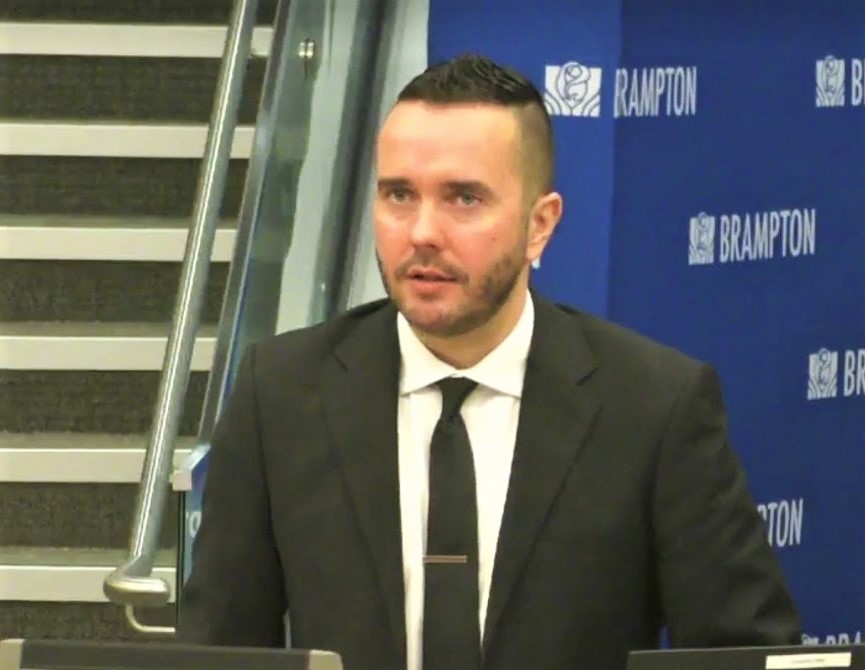
David Barrick was harshly criticized by Niagara Region councillors for presenting conservation agency budgets with millions of dollars he could not account for.
(Screengrab City of Brampton-YouTube)
It was learned that Barrick had given lavish car allowances to allies he promoted up the ranks, and there were many other questions from regional councillors that he refused to answer.
In Brampton, some council members seem determined to make sure Barrick and Brown are held accountable for their use of money provided by the city’s taxpayers.
There was plenty of confusion during the first days of scrutiny of Barrick’s budget document.
"In the reserve for the hospital levy, we have $42.6 or is it $40.6?" Councillor Pat Fortini asked staff, posing a seemingly simple question.
"We have $22 million in the hospital reserve for Peel Memorial Phase Two–," Mark Medeiros, the director of finance, said before he was cut off.
"But that was leftover from the last hospital [levy],” Fortini interrupted. “I'm talking about the reserves now. It was $20 [million] plus interest, around $22 million, that was leftover [from] the hospital levy. What's leftover from unspent capital projects? Is it $42.6?"
Medeiros offered a confusing reply, trying to explain the report on money that was supposed to have been spent on previously approved capital projects. "This report speaks specifically to the return of capital, not to total funding available. We have over $140 million in strategic reserves, the [Centre For Innovation] adding on top of that, you know $150 million, so this is not total funding available. This is just talking about opportunities to return back."
Fortini, who is pushing for council to fund its share of healthcare expansion, continued to debate with staff about capital funds which staff have now claimed could be repurposed to pay for a required local share of Peel Memorial’s redevelopment capital cost.
Fortini and City staff kept lobbing vastly different numbers through the air in a conversation that made it clear just how poorly key financial information is being communicated.
The 2022 budget process has cast doubt upon the City’s ability to deliver the projects it promises. It has also made it unclear if staff are actually in full control of projects and budgets, with tens of millions essentially being lost, or no longer needed.
Brampton is in the middle of a desperate rush to pass its 2022 budget by December 8.
Wednesday evening discussions continued until 11:20 P.M., following two days of marathon meetings that stretched between 9:30 A.M. and 8 P.M. on Monday alone. Friday’s meeting has been cancelled and budget committee will reconvene on Monday.
The scramble to pass the budget, along with the City’s revolving door of senior staff, has seen multiple instances where highly-paid bureaucrats simply don’t have information available when councillors ask.
"I'd like to pass this question to my colleague Mark [Medeiros]," was a common refrain from Nash Damer, Brampton’s new treasurer, who seemed out to sea for much of the budget deliberation. He was unable to answer questions about why 2021 budget forecasts had been changed or to explain the perplexing $69 million unspent capital report.
Simple questions were met with long pauses and senior staff fumbling for answers.
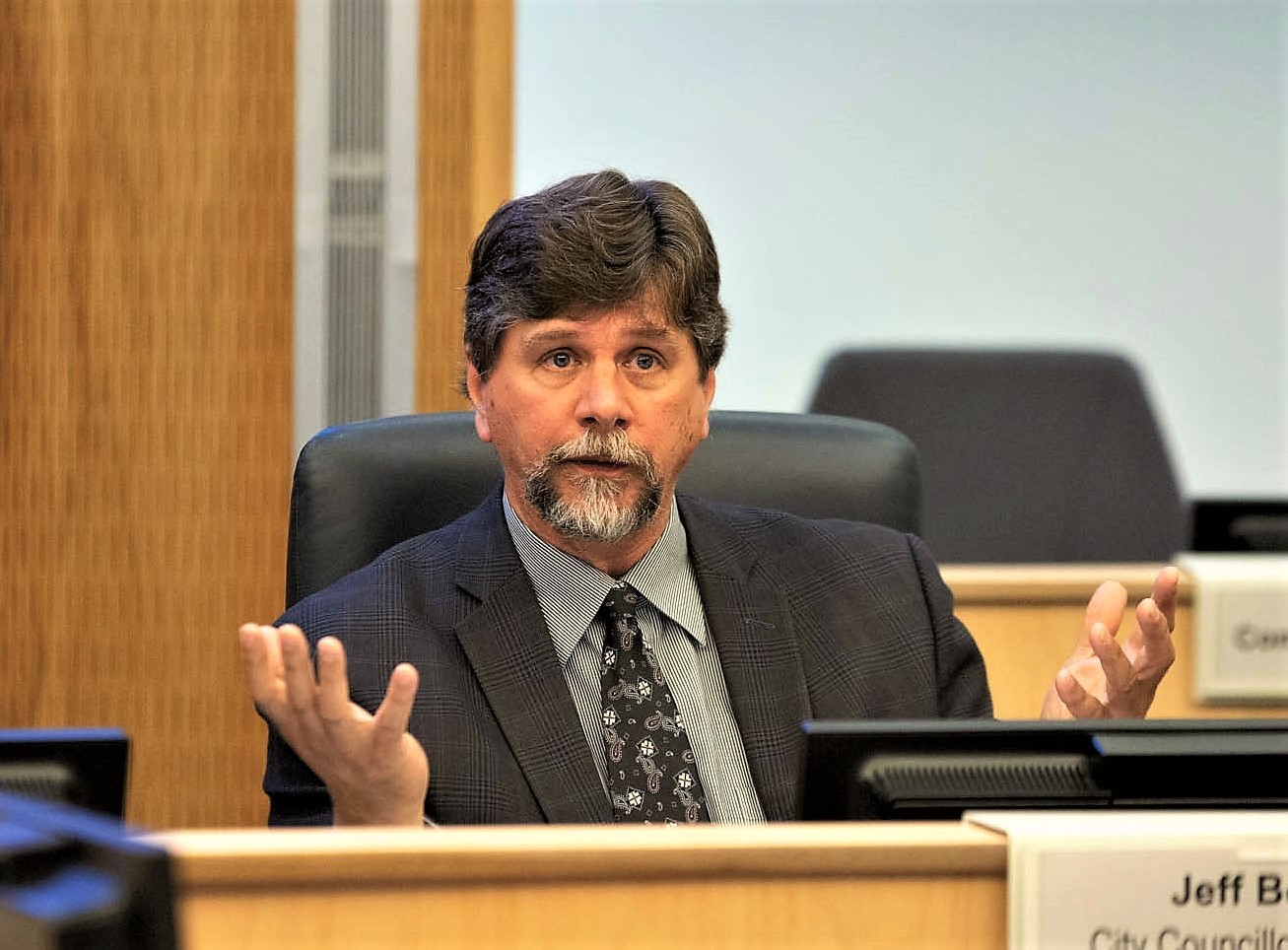
Councillor Jeff Bowman could not get answers to basic budget questions as staff were at a loss to explain their own numbers.
(The Pointer file photo)
Asked by Councillor Jeff Bowman on Tuesday how many consultants were under his command, Brampton's director of communications, Jason Tamming, who was fired from Niagara Region after his corrupt behaviour in the hiring process for its former CAO, was at a loss.
“Um, yeah, there’s professional, so for, um, our total, my understanding, what I’m seeing, our total, through the chair, it’s about 266. The large, primarily consultants would be in, um, the cultural services area, councillor.”
Tamming eventually clarified he meant $266,000 for a "handful" of consultants, not 266 separate consulting contracts. But it remained unclear why he described the employment generally under the “cultural services” department, and he did not offer an explanation of how many staff he hired as consultants or contract workers.
In some cases, staff are scrambling to produce last-minute reports for later in the week that will hopefully contain the answers to basic questions, at other times the answers are simply emailed to councillors, cutting the public out of an already deplorably inaccessible process with little transparency.
This confusion and imprecision are mirrored in the budget itself, for example around the question Bowman asked about the use of consultants by Tamming, which often does not allow council and the public to hold these temporarily hired individuals accountable for their work, and in some cases allows people like Tamming to use individuals whose conduct is not covered under various oversight legislation.
The budget document includes millions of dollars for consultants and contracted workers.
At least $19 million of labour costs in corporate services and community services alone will be paid to “Contracted Services”.
Damer has spent much of the budget deliberations passing questions to his colleagues, or promising information will be shared with councillors at a later date. Damer answers to Barrick, who was handpicked by Brown in 2019 to be the City’s top civil servant. Barrick is responsible for the entire City operation.
The numbers in the proposed budget document presented by the controversial CAO do not suggest a well-run city.
Instead of using reserve accounts the way they are intended, Barrick has been adding to these rainy-day funds heavily in the beginning of the year, then drawing them down for a range of costs later. This is not how budgeting of public money is supposed to be done. Reserve funds have specific uses to protect taxpayers from unforeseen circumstances and to cover specific costs. Barrick instead uses them to pay for expenses that are supposed to come out of departmental budgets after they have been carefully accounted for and detailed in the line items each area of the City’s operation is supposed to present during budget season so the public and elected officials can scrutinize the financial requests brought forward by staff.
This routine accountability process is not being followed by Barrick.
An investigation by Deloitte into corruption allegations inside City Hall that centred on Barrick delivered its findings in September. The final result, after investigators from the firm (whose selection for the job was shrouded in secrecy) were unable to complete interviews and had access to key documents blocked, cleared Barrick of the narrow issues that were probed, while many of the most alarming allegations were not dealt with. Despite this, the findings documented alarming behaviour by Barrick.
The report confirmed the CAO deliberately hired candidates without the relevant experience to hold key roles within City Hall. Multiple examples in the report show Barrick subverting the hiring process to push his preferred, and under-educated, candidates into important roles paid for by taxpayers.
In July of 2020 Barrick, according to Deloitte, selected two new “Directors for departments responsible for managing critical city infrastructure.” The job postings stated that university engineering degrees were a requirement for the jobs, as well as professional accreditations that allowed them to perform or approve highly technical work. The successful candidates should have “7-10 years of managerial experience with at least 5 years of experience in project management and construction,” according to the report.
The men Barrick chose himself didn’t even have engineering degrees. “Deloitte did not identify any indications of construction experience on either candidate’s CV," the report says. Despite his alarming conduct, Deloitte accepted there was nothing wrong with Barrick’s explanation that he simply changed the hiring requirements himself at the last minute and also had the authority to change policies on the fly which allowed him to override existing HR rules.
Essentially, all Barrick had to do was change the rules he violated, as he was carrying out his misconduct. “Certain policies and standard operating procedures were revised or updated by the CAO contemporaneously with alleged activity,” Deloitte wrote in its report.
Now, men like the two Barrick hired for the engineering jobs even though they are not engineers, are putting together a billion dollar City budget that in dozens and dozens of cases does not offer even basic details of the use of public funds.
The chaos within City Hall, allegations of corruption and evidence of delinquent hiring do not make for good governance. The long-term impacts of spontaneous budget freezes and questionable hires will ultimately come back to hurt residents and businesses, as pointed out by members of the public.
“Anytime you have a large organization like this, it is really important to be diligent, and that's complicated,” Michelle McCollum, Chair of the Brampton Board of Trade, said. She was responding to a question from Brown asking her to make suggestions about which parts of the City administration might be “bloated”.
“It is important that you have the leadership in place that understands exactly what's happening in every area,” she said. “It's not possible for Glenn and [me] to sit here and say, ‘Well, [in] recreation, you could be doing something different or in bylaw, maybe you need one less officer.’ … What we're seeing is that you need to have the right leaders in place with the right experience, to be hiring the right people, and to be making the right decisions for our business community.”
The pressures on the 2022 budget are immense.
In its current form, staff are suggesting councillors adopt a 2.8 percent increase, a figure that does not include a three percent levy increase staff suggested last year. Mayor Patrick Brown has already publicly confirmed he will attempt to squeeze a fourth populist tax freeze from the already gutted budget, which has completely ignored the city’s most pressing needs, such as a new hospital and its first university.
There is pressure to fund Brampton’s share of a provincial expansion to Peel Memorial Centre for Integrated Health and Wellness, currently estimated at $125 million. That money could come from a special levy that would increase the property tax rate, something Brown is desperate to avoid.
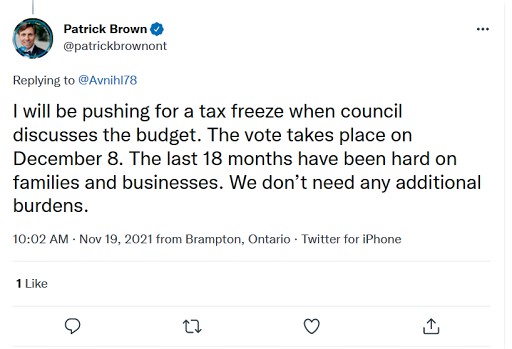
Patrick Brown is once again promising a tax freeze.
(Screenshot from Twitter)
The budget also relies heavily on debt funding for a range of projects and includes no plans to realize the City’s ambitions for a light rail transit system on Main Street or a bus rapid transit route along Queen Street.
Promises Brown has guaranteed are also absent in the proposed 2022 budget. There is no money for his Brampton University plan, despite all of Brown’s trumpeting of the idea and hundreds of thousands spent on consultants early in the council term. Even the “state of the art world class” cricket stadium he promised to fans of the sport has been left out of the 2022 financial proposal.
Meanwhile, infrastructure has decayed under his tax freezes and the city centre, the catalyst to attract investments in Brampton, has succumbed to years of neglect under Brown after he cancelled the major redevelopment of the area right after his election, which helped him achieve his tax freezes. Even that claim is misleading, as taxes for many have gone up with assessment increases, while utilities have skyrocketed and some user fees have increased.
Brown’s shell game came under fire this week.
“We certainly don't want to have large increases, we want predictability,” Williams said. “And our concern here is that if we're essentially shifting some costs to the future, … if we keep deferring the Day of Judgement, if you will, there will be a huge impact in two, three, four years. And so we think that financial discipline needs to start now.”
With so many complicated decisions to weigh, it is unclear why councillors discussed the budget until almost midnight, galloping towards an arbitrary deadline of December 8.
Brampton plans to pay for almost seven percent of its $328 million capital budget through debt that will need to be repaid in years to come.
Brown has used the argument that low taxes attract business investments in his attempts to push budget freezes during his tenure as mayor. It’s an argument the Brampton Board of Trade says just doesn’t hold water.
Brampton’s business community has effectively said it is losing faith in council’s ability to budget and govern. The fallacy that a zero percent budget increase is good, rather than simply politically popular, was laid bare by the very people it was purportedly meant to satisfy.
“That is our point: that the decisions that budget committees recommend really needs to be about longer-term sustainability, rather than just kind of election cycle to election cycle,” McCollum told councillors. “It is essential that we have that predictability, that we have that stability for the business community.”
COVID-19 is impacting all Canadians. At a time when vital public information is needed by everyone, The Pointer has taken down our paywall on all stories relating to the pandemic and those of public interest to ensure every resident of Brampton and Mississauga has access to the facts. For those who are able, we encourage you to consider a subscription. This will help us report on important public interest issues the community needs to know about now more than ever. You can register for a 30-day free trial HERE. Thereafter, The Pointer will charge $10 a month and you can cancel any time right on the website. Thank you
Submit a correction about this story


